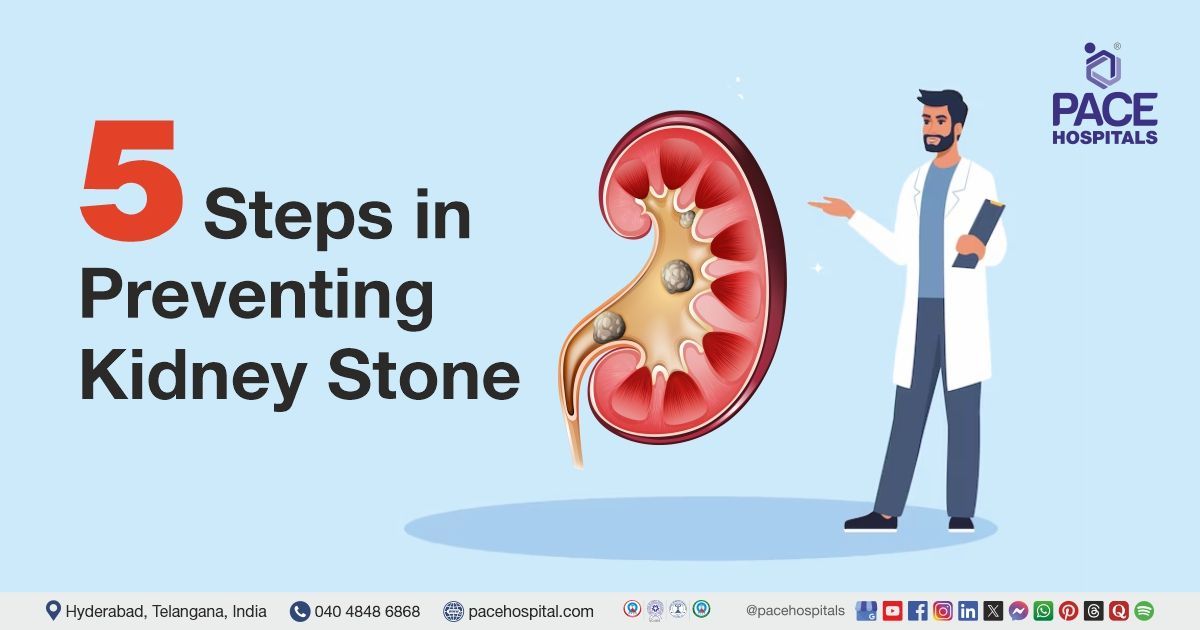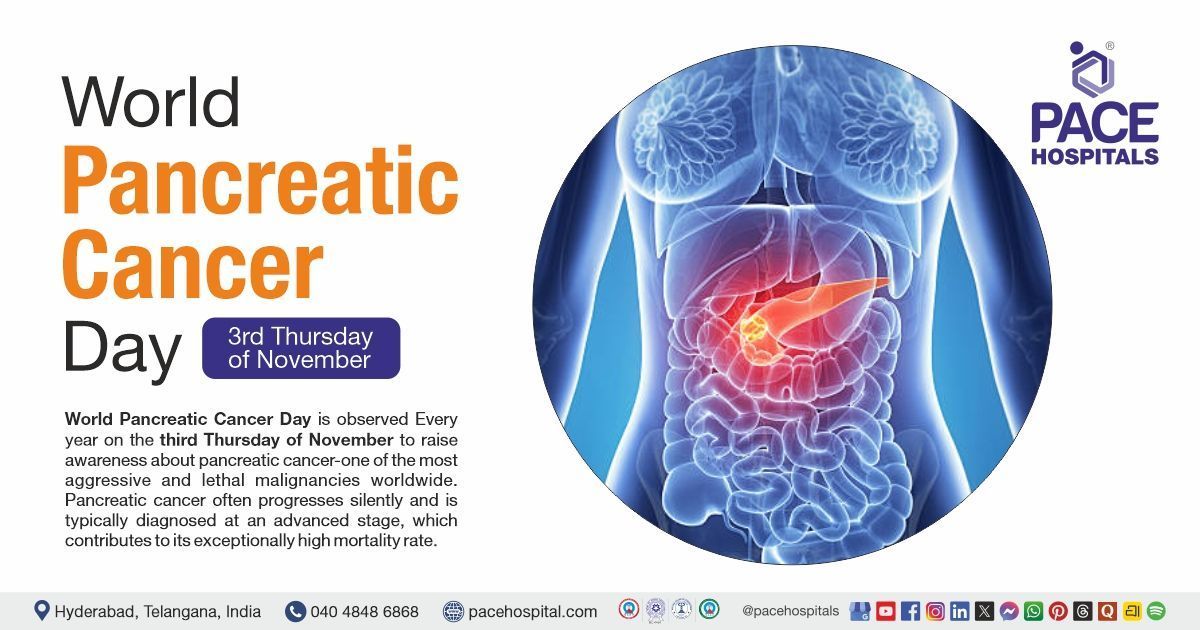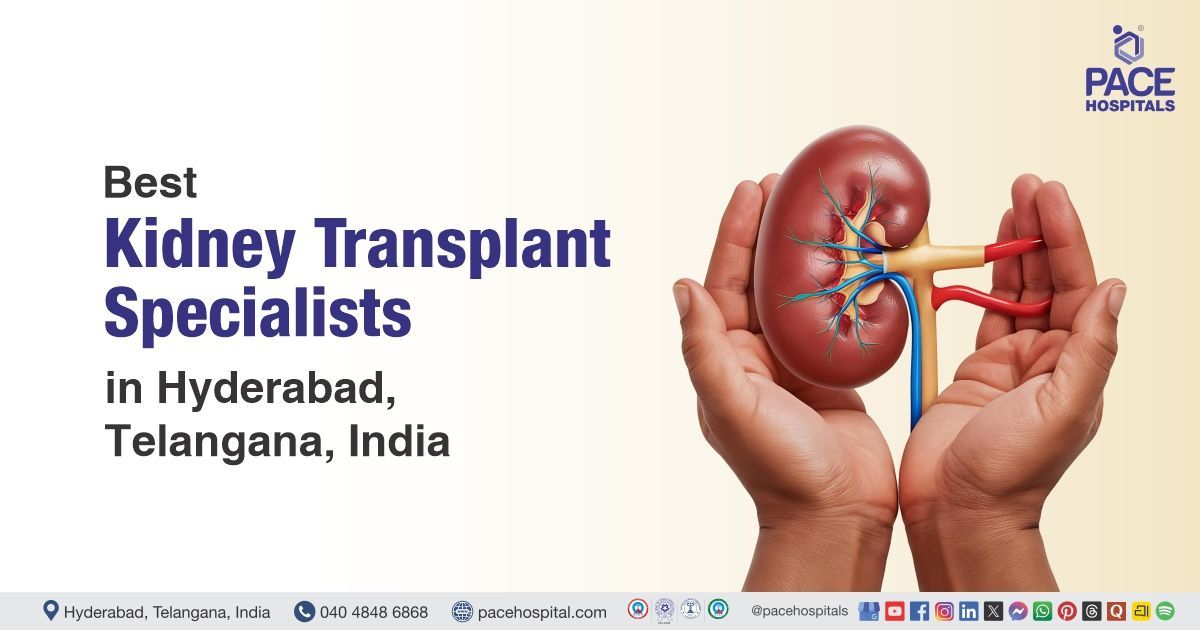Juvenile Idiopathic Arthritis - Types, Symptoms, Causes, Diagnosis & Treatment
PACE Hospitals
Written by: Editorial Team
Medically reviewed by: Dr. Shweta Bhardwaj - Consultant Rheumatologist and Clinical Immunologist
Overview | Prevalence | Types | Symptoms | Causes | Risk Factors | Complications | Diagnosis | Treatment | Prevention | Juvenile Idiopathic Arthritis vs Rheumatoid Arthritis | FAQs | When to consult a Doctor
Juvenile idiopathic arthritis definition
Juvenile idiopathic arthritis (JIA) is a chronic or long-lasting autoimmune disease causing persistent joint inflammation in children under 16 years of age. It lasts for at least six weeks and varies in severity. If not treated early, it may affect physical development.
Common signs of juvenile idiopathic arthritis include joint pain, edema, and stiffness. The condition can vary from minimal joint involvement to severe disease with systemic symptoms. If JIA is not detected and treated promptly, it can result in joint damage and diminished growth. Early evaluation and management by a pediatric rheumatologist are essential to control symptoms and prevent long-term complications.
Juvenile idiopathic arthritis meaning
The term Juvenile Idiopathic Arthritis consists of three segments. Juvenile is derived from the Latin term for "pertaining to young people," suggesting that the disease affects children. Idiopathic is derived from Greek, meaning "of unknown cause," while arthritis derives from Greek roots meaning "joint inflammation." Together, the terms refer to a chronic inflammatory joint condition of unknown etiology that affects children under 16 years old.
Prevalence of Juvenile Idiopathic Arthritis
Prevalence of juvenile idiopathic arthritis in the world
According to recent worldwide studies, the global prevalence of juvenile idiopathic arthritis (JIA) varies from 3.8 to 400 cases per 100,000 children, depending on location, diagnostic criteria, and availability to medical care. In high-income countries like the United States and Europe, the prevalence ranges from 45 to 70 per 100,000 children. By 2025, it is estimated that over 30 lakh children and young adults globally will have JIA. These findings underline the vital importance of early identification, greater access to pediatric rheumatology care, and enhanced global awareness in reducing disease burden and long-term disability.
Prevalence of juvenile idiopathic arthritis in India
In India, the estimated prevalence of juvenile idiopathic arthritis (JIA) is approximately 48 per 100,000 children (0.048%), based on a school-based study conducted in northern India. However, more recent hospital-based data suggest a lower diagnosed prevalence of about 0.001% among children under 16 years. These figures indicate that while JIA is relatively uncommon, it still represents a significant cause of chronic illness in Indian children. Variations in data may be due to differences in healthcare access, underdiagnosis, and a lack of large-scale population-based studies.

Juvenile Idiopathic Arthritis Types
Juvenile idiopathic arthritis (JIA) is of several types based on symptoms, the number of joints involved, and other features. The following are the different types of juvenile idiopathic arthritis:
- Oligoarticular juvenile idiopathic arthritis
- Polyarticular juvenile idiopathic arthritis (RF-negative )
- Polyarticular juvenile idiopathic arthritis ( RF-positive)
- Systemic juvenile idiopathic arthritis (Still’s disease)
- Enthesitis-related juvenile idiopathic arthritis
- Psoriatic juvenile idiopathic arthritis
- Undifferentiated arthritis
Oligoarticular juvenile idiopathic arthritis
It is the most common type and is defined by arthritis affecting four or fewer joints during the first six months of the disease. It typically involves larger joints such as the knees, ankles, or elbows. Children with oligoarticular JIA often have a mild course of arthritis, but this type is frequently associated with eye inflammation called uveitis, which can result in serious complications if not detected early. Regular eye examinations are essential for children with this type.
Polyarticular juvenile idiopathic arthritis – Rheumatoid factor negative:
This is the second most common type of JIA and affects five or more joints within the first six months. Children with this type test negative for rheumatoid factor, a blood test used to detect autoimmune diseases like adult rheumatoid arthritis. Some children, especially young girls with a positive anti-nuclear antibody (ANA), may develop chronic uveitis (eye inflammation).
Polyarticular juvenile idiopathic arthritis – Rheumatoid factor positive:
In this type, a child has arthritis in five or more joints during the first six months and tests positive for rheumatoid factor. It is more frequent in preteen and adolescent girls and closely resembles adult rheumatoid arthritis, with autoantibodies which include rheumatoid factor (RF) and anti-citrullinated protein antibodies (ACPA).
Systemic juvenile idiopathic arthritis (Still’s disease)
It is also known as Still's disease. It is characterised by arthritis accompanied by systemic symptoms such as high spiking fevers, a salmon-coloured rash, swollen lymph nodes, and inflammation of internal organs like the liver and spleen. The fevers typically occur daily and are a hallmark of this type. Because systemic JIA affects the entire body, it can be more severe and requires more powerful treatments to manage extensive inflammation.
Enthesitis-related juvenile idiopathic arthritis
It primarily affects entheses, or the areas where tendons and ligaments join to bones. This inflammation typically affects the lower limbs and spine. ERA is more common in boys over the age of six and is closely linked to the presence of the HLA-B27 genetic marker. Symptoms can include pain and swelling around the heels, knees, and lower back. This type is part of a larger group of diseases called spondyloarthropathies.
Psoriatic juvenile idiopathic arthritis
It occurs in children who have psoriasis, a chronic (longterm) skin condition characterized by red, scaly patches. This type of juvenile idiopathic arthritis (JIA) involves joint inflammation and can cause dactylitis, which is swelling of the entire fingers or toes, giving them a "sausage-like" appearance. Nail changes, such as pitting or ridging, are common and can help with diagnosis. Joint discomfort might vary from minor to severe.
Undifferentiated arthritis
It is a category used when a child's symptoms do not clearly fit any of the other defined JIA subtypes, or when they meet criteria for more than one subtype. Because this category is more variable, treatment and prognosis depend on the specific symptoms and severity observed in each child.
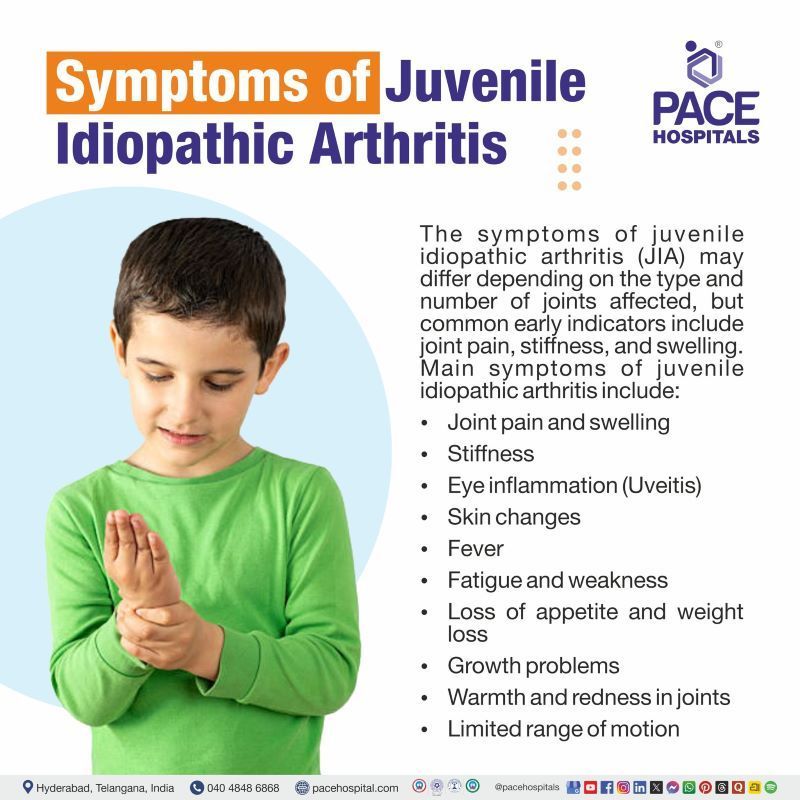
Juvenile Idiopathic Arthritis Symptoms
The symptoms of juvenile idiopathic arthritis (JIA) may differ depending on the type and number of joints affected, but common early indicators include joint pain, stiffness, and swelling. In some cases, the condition can damage the skin, eyes, or growth. Identifying these symptoms early is critical for quick diagnosis and appropriate treatment.
Main symptoms of juvenile idiopathic arthritis include:
- Joint pain and swelling
- Stiffness
- Eye inflammation (Uveitis)
- Skin changes
- Fever
- Fatigue and weakness
- Loss of appetite and weight loss
- Growth problems
- Warmth and redness in joints
- Limited range of motion
Joint pain and swelling: Children with JIA often experience pain, swelling, and tenderness in one or more joints. Larger joints, such as knees, wrists, and ankles, are commonly affected, and the pain may worsen after rest.
Stiffness: Joint stiffness is usually most noticeable in the morning or after periods of inactivity. A child may limp or struggle to move joints freely, especially after waking up.
Eye inflammation (Uveitis): Uveitis, an inflammation of the eye, is common in JIA and may occur before or after joint symptoms. Chronic uveitis often has no symptoms but can lead to serious complications like cataracts or vision loss if untreated, so regular eye examinations are essential.
Skin changes: Systemic JIA can cause a faint pink rash that appears with fevers. Psoriatic JIA may cause scaly red skin patches, pitted nails, and sausage-like swelling of fingers or toes (dactylitis). Nodules may appear in RF-positive polyarticular JIA.
Fever: Children with systemic JIA often have daily high fevers, usually in the evening, that may be accompanied by a rash. Other types of JIA generally do not cause fever unless there is a flare or infection.
Fatigue and weakness: Chronic inflammation in JIA can make children feel tired, weak, or low on energy. This can interfere with daily activities and school performance.
Loss of appetite and weight loss: Pain, inflammation, and systemic symptoms may lead to reduced appetite. Over time, this can cause weight loss or failure to gain weight, typically.
Growth problems: Inflammation near growing bones can slow or speed up bone development, causing uneven limb lengths. Severe disease or long-term steroid use may result in overall slowed growth.
Warmth and redness in joints: Inflamed joints may feel warm to the touch and appear red. This is due to increased blood flow and inflammation in the joint area.
Limited range of motion: As inflammation damages the joint or causes pain, a child may avoid fully using the joint. Over time, this can lead to reduced flexibility or joint deformities.
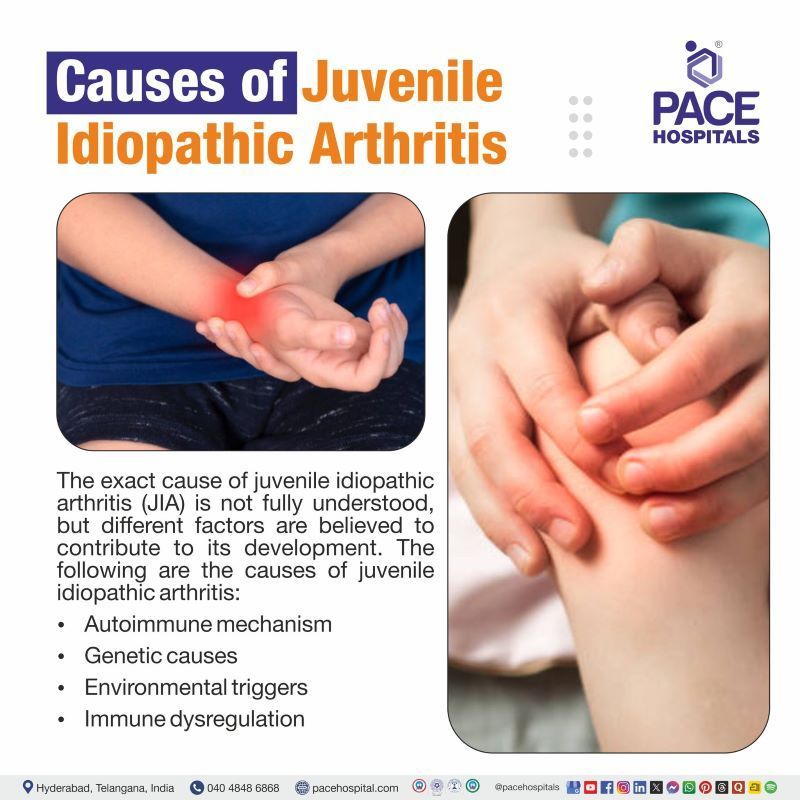
Juvenile Idiopathic Arthritis Causes
The exact cause of juvenile idiopathic arthritis (JIA) is not fully understood, but different factors are believed to contribute to its development. The following are the causes of juvenile idiopathic arthritis:
- Autoimmune mechanism
- Genetic causes
- Environmental triggers
- Immune dysregulation
Autoimmune mechanism: JIA is an autoimmune disease, which means that the immune system attacks the body's own tissues, particularly the synovium. This causes prolonged inflammation, discomfort, swelling, and possible joint injury.
Genetic causes: Specific genes related to immune system regulation make a child more prone to autoimmune diseases. Specific Human Leukocyte Antigen (HLA) genes, such as HLA-DRB1, HLA-B27, and HLA-A2, increase susceptibility. Additionally, mutations or polymorphisms in immune-related genes like PTPN22, STAT4, and IL2RA have been linked to the development of these conditions.
Environmental triggers: Infections, whether viral or bacterial, may trigger the syndrome in genetically susceptible infants by eliciting incorrect immune responses. Stress or trauma may influence immune activation, but evidence is sparse. Furthermore, exposure to toxins or smoking during early childhood can affect immune function.
Immune dysregulation: Chronic inflammation is caused by excessive production of inflammatory cytokines, including TNF-α, IL-1, and IL-6. A failure in immune regulatory pathways, particularly involving T-regulatory cells, allows persistent joint inflammation.
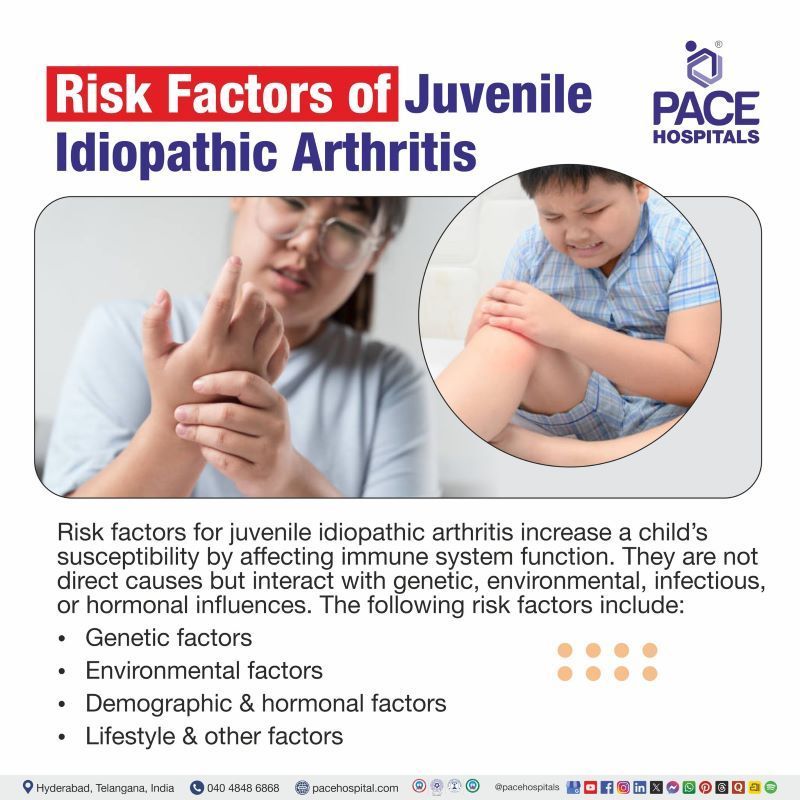
Juvenile Idiopathic Arthritis Risk Factors
These factors increase a child's risk of developing juvenile idiopathic arthritis by affecting the immune system function and response to triggers. While not direct causes, they raise susceptibility when combined with genetic, environmental, infectious, or hormonal influences. The following risk factors include:
- Genetic factors
- Environmental factors
- Demographic & hormonal factors
- Lifestyle & other factors
Genetic factors: A family history of autoimmune illnesses like rheumatoid arthritis, lupus, or type 1 diabetes might place a child at risk. The presence of risk HLA genes, such as HLA-DRB1, HLA-B27, and HLA-A2, is also related to increased susceptibility. Variations in immune-related genes such as PTPN22, STAT4, and IL2RA also increase genetic risk.
Environmental factors: In genetically predisposed people, viral or bacterial infections can cause autoimmune responses. Low vitamin D levels can impair immunological function and control. Altered gut microbiota, which is crucial for immune system development, has also been associated with various health conditions. Cigarette smoke, especially passive smoking, raises the risk. Perinatal issues such as preterm delivery or low birth weight may also be involved.
Demographic & hormonal factors: The condition usually affects children under the age of 16, with the highest incidence between 1 and 3 years old. Females are more commonly affected than males, especially in oligoarticular and polyarticular subtypes. Hormonal influences may modulate immune function and increase the risk in girls.
Lifestyle & other factors: Psychological stress may disturb immune system homeostasis, thereby causing or exacerbating disease activity.
Obesity is another contributing factor since it promotes systemic inflammation, which can influence illness onset or progression.
Juvenile Idiopathic Arthritis Complications
Although many children with JIA live active lives with proper treatment, untreated or poorly controlled JIA can lead to several complications affecting various body systems. Below are some of the complications of JIA:
- Joint damage and deformities
- Growth problems
- Macrophage activation syndrome (MAS)
- Eye complications
- Osteoporosis and bone fragility
- Cardiopulmonary issues
- Chronic disability and reduced quality of life
Joint damage and deformities: Persistent inflammation can cause joint contractures, reduced range of motion, loss of function, and, in severe cases, early joint replacement. Joints such as the temporomandibular joint (jaw) and cervical spine can be affected, altering appearance and function.
Growth problems: Inflammation and certain medications, particularly corticosteroids, can compromise growth plate function, resulting in growth retardation, limb length differences, or deformities like a small chin caused by jaw involvement.
Macrophage activation syndrome (MAS): A rare but fatal (life-threatening) systemic inflammatory reaction occurring in about 10% of JIA cases, characterized by excessive immune activation that can severely affect organs.
Eye complications: Chronic eye inflammation (uveitis) can occur silently, risking cataracts, glaucoma, and vision loss if untreated. Regular ophthalmologic screenings are essential.
Osteoporosis and bone fragility: Long-term corticosteroid use can lead to decreased bone density, increasing fracture risk. Supplementation and exercise are recommended to support bone health.
Cardiopulmonary issues: Systemic JIA patients may develop lung problems such as pulmonary artery hypertension or interstitial lung disease, and hypertension may also occur.
Chronic disability and reduced quality of life: Ongoing disease activity can cause physical disability into adulthood.
Juvenile Idiopathic Arthritis Diagnosis
Diagnosing juvenile idiopathic arthritis (JIA) can be challenging, as there is no single test that confirms the disease. The pediatric rheumatologist will review the child's medical history and perform a physical examination. Symptoms and any recent illnesses will be assessed. A diagnosis of juvenile idiopathic arthritis (JIA) is based on signs of inflammation that have been present for six weeks or longer. The following diagnostic tests are used for juvenile idiopathic arthritis:
- Medical history
- Physical examination
- Laboratory tests
- Antinuclear antibody (ANA) test
- Complete blood count (CBC)
- Complement test
- Erythrocyte sedimentation rate (ESR)
- C-Reactive protein (CRP)
- Creatinine
- Hematocrit
- Rheumatoid factor (RF)
- White blood cell (WBC) count
- Anti-cyclic citrullinated peptide (anti-CCP)
- Imaging tests
- X-rays
- Computed tomography (CT) scan
- Magnetic resonance imaging (MRI)
- Bone scan
- Other tests
- Urine tests
- Joint aspiration (arthrocentesis)
- Full eye exam
Juvenile Idiopathic Arthritis Treatment
The major goals of juvenile idiopathic arthritis (JIA) treatment are to reduce inflammation, alleviate pain, maintain joint function, and avoid chronic joint damage. Management is tailored to each patient, depending on the type and severity of JIA. The following are the treatment options for JIA:
- Non-pharmacological management
- Pharmacological management
- Surgical management
Non-Pharmacological Management
- Physical and occupational therapy
- Exercise
- Patient and family education
- Regular eye examinations
- Psychosocial support
Pharmacological Management
- Nonsteroidal anti-inflammatory drugs (NSAIDs)
- Corticosteroids
- Disease-modifying anti-rheumatic drugs (DMARDs)
- Biologic agents
Surgical management
- Synovectomy
- Joint replacement (arthroplasty)
- Joint fusion (arthrodesis)
Why Choose PACE Hospitals?
Expert Super Specialist Doctors
Advanced Diagnostics & Treatment
Affordable & Transparent Care
24x7 Emergency & ICU Support
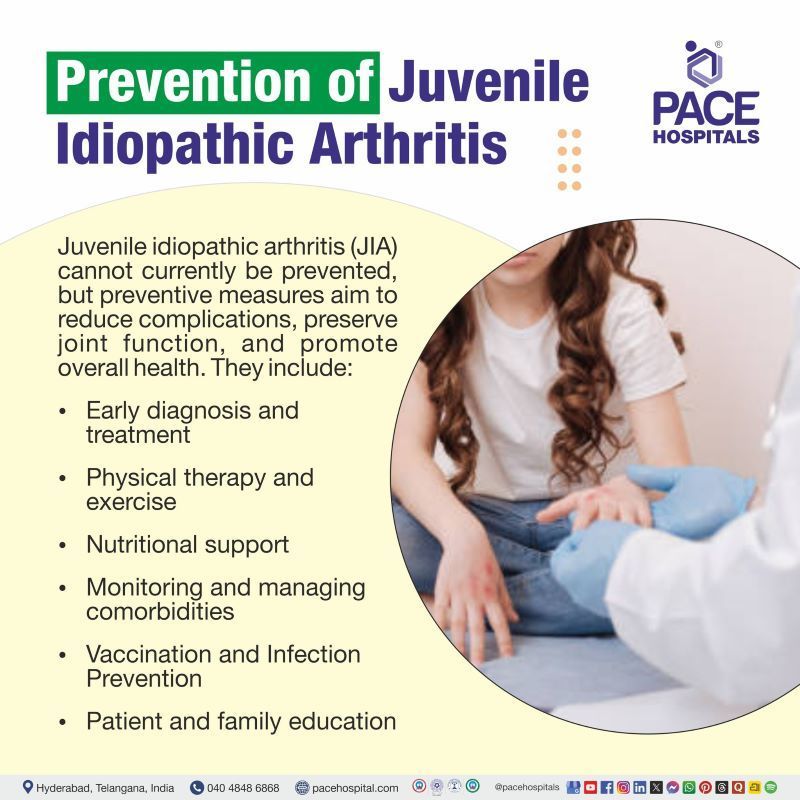
Juvenile Idiopathic Arthritis (JIA) Prevention
As an autoimmune disease with an unknown etiology, juvenile idiopathic arthritis (JIA) cannot be prevented at present. However, the goals of prevention techniques are to reduce complications, maintain joint function, and advance general health. They include:
- Early diagnosis and treatment
- Physical therapy and exercise
- Nutritional support
- Monitoring and managing comorbidities
- Vaccination and Infection Prevention
- Patient and family education
Early diagnosis and treatment: Proper identification and treatment with drugs such as Nonsteroidal Anti-Inflammatory Drugs (NSAIDs), Disease-Modifying Anti-Rheumatic Drugs (DMARDs), and biologics can help avoid joint injury and disease development.
Physical therapy and exercise: Regular exercise, such as flexibility and strength training, maintains joint mobility and stops muscle atrophy.
Nutritional support: Proper nutrition with vitamin D and calcium supports bone health and decreases osteoporosis risk related to the disease and corticosteroid use.
Monitoring and managing comorbidities: Regular screening for uveitis and other complications prevents permanent damage.
Vaccination and Infection Prevention: Vaccinations as per guidelines prevent infections that may trigger or worsen disease flares, with caution around live vaccines during immunosuppressive therapy.
Patient and family education: Educating caregivers and patients on adherence to therapy and lifestyle choices supports long-term disease control.
Difference between Juvenile Idiopathic Arthritis and Rheumatoid Arthritis
Juvenile idiopathic arthritis vs rheumatoid arthritis
Juvenile Idiopathic Arthritis (JIA) is a form of arthritis that affects children under 16, causing joint inflammation and stiffness. Rheumatoid Arthritis (RA), a chronic autoimmune disorder that causes joint degeneration, is more common in adults. While both involve immune system attacks on the joints, JIA can manifest differently and may impair growth and development. Below are some of the parameters that help in differentiating Juvenile idiopathic arthritis and rheumatoid arthritis:
| Parameters | Juvenile Idiopathic Arthritis (JIA) | Rheumatoid Arthritis (RA) |
|---|---|---|
| Definition | A chronic autoimmune arthritis causing joint inflammation in children under 16 years old. | A chronic autoimmune disease causing inflammation and damage to joints, mainly in adults. |
| Age of onset | Before 16 years old. | Typically, adults are aged 30-50. |
| Cause | Autoimmune; exact cause unknown; possible genetic factors. | Autoimmune; genetic and environmental factors (e.g., smoking). |
| Joint involvement | Large and small joints, as well as growth plates, may be affected. | Primarily, small joints are symmetric (hands, wrists). |
| Symptoms | Joint pain, swelling, stiffness; may include fever and rash. | Joint pain, swelling, stiffness, prolonged morning stiffness, fatigue. |
| Extra-articular features | Uveitis (eye inflammation) is common; systemic symptoms are present in some subtypes. | Lung, heart, eye, and blood vessel involvement |
Frequently Asked Questions (FAQs) on Juvenile Idiopathic Arthritis
What is Juvenile Idiopathic Arthritis (JIA)?
Juvenile Idiopathic Arthritis (JIA) is a chronic autoimmune condition that causes joint inflammation in children. It develops when the immune system mistakenly targets healthy joint components, causing pain, swelling, and stiffness that lasts at least 6 weeks. "Idiopathic" indicates that the reason is uncertain. JIA can impact one or more joints, as well as other organs such as the eyes, bones, or skin.
Does juvenile arthritis go away?
Juvenile arthritis may go into remission and not return, especially if treated early. However, the course of the condition varies greatly amongst individuals. Some children may have continuing symptoms till adulthood. Regular follow-up and therapy are required to control flares and limit the risk of irreversible joint damage. While the condition may subside, it does not always go away entirely without long-term care.
Can kids with JIA play sports?
Children with JIA are often encouraged to participate in physical activities, including sports, as long as the activity is appropriate to their condition. Low-impact activities like swimming, riding, and walking help maintain strong muscles and flexible joints. To avoid stress during flare-ups, participation in sports must be monitored by a doctor. Managing symptoms, elevating mood, and maintaining general physical health all depend on physical activity.
What causes Juvenile Idiopathic Arthritis (JIA)?
Although the exact cause of JIA is unknown, a combination of immunological, genetic, environmental, and hormonal factors are thought to be responsible. The immune system mistakenly attacks the body's own tissues, causing inflammation. Specific genes make children more likely to develop the disease. Infections or environmental triggers may activate it in genetically prone children, and hormonal changes might influence when or how it develops.
How severe is juvenile idiopathic arthritis?
Idiopathic arthritis in children can range from mild and self-limiting to severe and chronic. While certain children get remission, others might get growth issues, long-term joint damage, and side effects like uveitis, which is an irritation of the eyes. With early diagnosis and effective treatment, most children can lead active, fulfilling lives. However, untreated or poorly managed cases may result in disability. The seriousness depends on the subtype, severity, and responsiveness to therapy.
How to relieve juvenile arthritis?
Relieving juvenile arthritis involves a combination of medical treatment, physical therapy, and lifestyle adjustments. Nonsteroidal anti-inflammatory drugs (NSAIDs), DMARDs and biologics may be used. Regular exercise promotes flexibility, while heat/cold therapy alleviates pain. Adequate rest, stress reduction, and dietary assistance can all help with symptom control. Individualised care plans produced in collaboration with physicians are important for illness management and quality of life improvement.
Can JIA affect the brain?
Although juvenile idiopathic arthritis has no direct effect on brain cells, chronic inflammation, pain, and certain drugs can all have an impact on mental and emotional health. Children with JIA may experience fatigue, difficulties concentrating, or mood swings like anxiety or depression. These secondary effects require monitoring and may benefit from psychological support. Although neurological complications are rare, comprehensive care often includes attention to cognitive and emotional development.
What is the most severe complication of juvenile idiopathic arthritis?
The most severe complication of JIA is joint damage and deformity resulting from chronic inflammation. Additionally, uveitis can cause permanent vision impairment if untreated. In rare cases, systemic JIA can lead to macrophage activation syndrome (MAS), a life-threatening inflammatory reaction.
What are the key signs of a patient with juvenile idiopathic arthritis?
Key signs include swollen, warm, and stiff joints, especially in the morning. Children may have reduced movement, fatigue, or limping without injury. In some cases, eye redness, rash, or fever may also occur, depending on the subtype of the disease.
What are the symptoms of juvenile arthritis in children?
Symptoms of juvenile arthritis include joint pain, swelling, stiffness, and warmth, often worse in the morning or after rest. Affected children may show fatigue, fever, or rash and may limp or struggle with movement. Some may experience eye inflammation or delayed growth if the disease is long-lasting or severe.
Does JIA turn into RA?
Not all cases of JIA progress into rheumatoid arthritis (RA), but some subtypes, particularly rheumatoid factor-positive polyarticular JIA, resemble adult RA and may continue as RA into adulthood. Other forms of JIA may go into remission or evolve differently over time. The risk of progression depends on genetic factors, disease severity, and response to treatment. Lifelong monitoring helps determine if the disease transitions into adult inflammatory arthritis.
How to help your child with JIA?
Supporting children with JIA involves developing a complete care plan that includes medical treatment, lifestyle changes, and emotional support. Parents need to ensure that their children take their medications on schedule, attend regular follow-up appointments, and provide adequate physical activity. Open conversations about pain and restrictions can help children manage. Educating teachers and peers about JIA fosters greater understanding. A balanced diet and a supportive environment help with disease management and mental health.
How to stop arthritis from getting worse?
To prevent arthritis from worsening, early diagnosis and regular therapy are essential. Medications such as NSAIDs, DMARDs, or biologics help control inflammation. Regular exercise, physical therapy, and a healthy diet support joint function. Ongoing medical supervision helps detect and manage flare-ups early.
What are the first signs of arthritis in the legs?
Early signs of arthritis in the legs may include joint pain, stiffness (especially in the morning), swelling, redness, and warmth around the knee, ankle, or hip. Children may limp or avoid using the affected leg due to discomfort. In some cases, there may be no visible swelling, but decreased movement or function is noted. Persistent symptoms need evaluation by a pediatric rheumatologist to determine if JIA is present.
When to consult a doctor for juvenile idiopathic arthritis?
Consult a doctor for juvenile idiopathic arthritis (JIA) if joint pain, swelling, or stiffness persist for several weeks, get worse, or make movement difficult. Signs that need prompt treatment include:
- Persistent joint pain, warmth, or swelling
- Morning stiffness or limping without injury
- Fatigue, fever, or unexplained rash
- Eye redness, pain, or blurred vision
- Slowed growth or uneven limb length
If these symptoms continue, it is important to consult a pediatric rheumatologist who can evaluate the cause and recommend the right treatment plan. Seek emergency medical attention if there is sudden, severe pain, rapid swelling, or vision changes, which could suggest a serious complication. A pediatrician, rheumatologist, or ophthalmologist can provide the best juvenile idiopathic arthritis (JIA) treatment to control the disease and prevent long-term joint or eye damage.
Share on
Request an appointment
Fill in the appointment form or call us instantly to book a confirmed appointment with our super specialist at 04048486868




